Roger Bergs offers fresh treatments of three traditional hymns, one each for Advent, Christmas, and Epiphany. On these pages, Bergs, a published composer, not only provides arrangements for piano and/or organ or choir, but also offers them without charge to Reformed Worship and to our readers—a generous gift!—ERB
Editor Note: The music included here is incomplete because PDFs of the arrangements by Bergs are no longer available. What appears below are scans of what was printed in the original issue.
Advent: Lord, You Were Rich
For you know the grace of our Lord Jesus Christ, that though he was rich, yet for your sake he became poor, so that you by his poverty might become rich.
—2 Cor. 8:9, ESV
“Lord, You Were Rich” is the title Jubilate Hymns gave to their modern English version of Frank Houghton’s text “Thou Who Wast Rich.” When it is sung to the tune FRAGRANCE (sometimes called quelle est cette odeur agreable), the combination of text and tune provides a strong and powerful gospel message.
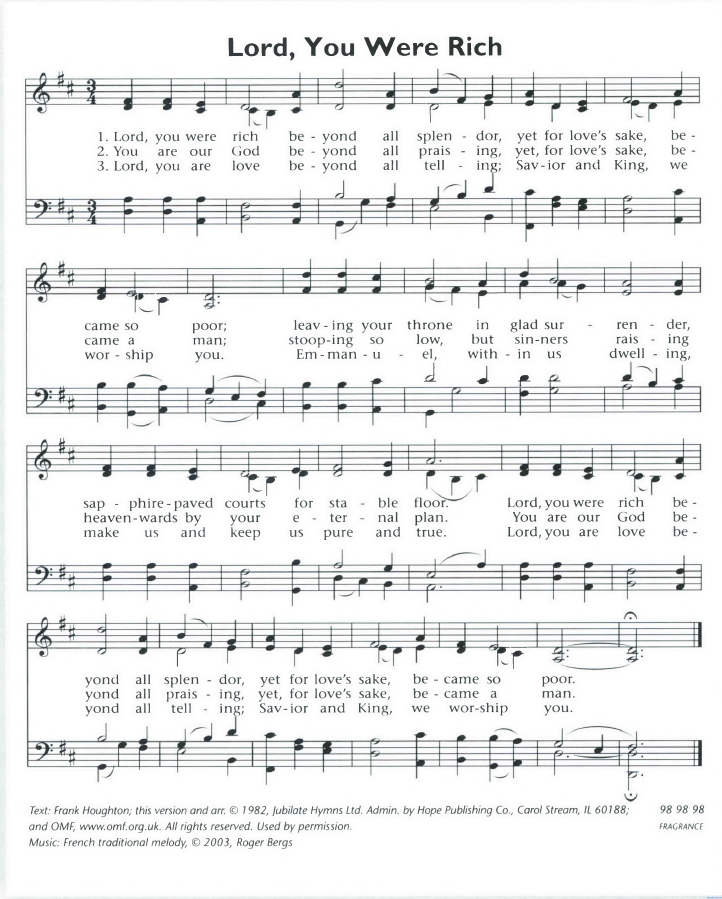
Frank Houghton (1894–1972) was a missionary who held the position of Anglican bishop of East Szechwan, and later served as general director of the China Inland Mission (CIM, now Overseas Missionary Fellowship). This hymn was written in the early 1930s at a time of severe persecution of Chinese Christians and foreign missionaries. The news of the beheading of two missionaries by the advancing Red Army reached the Shanghai headquarters of CIM in 1934. Houghton decided to visit and encourage his missions’ workers in their scattered outposts throughout the country. While he was traveling through the mountains of eastern Szechwan, the words of 2 Corinthians 8:9 inspired this text.
The text is a real gem—a refined poetic expression that is simple enough for children. Consider the lyric: [Christ exchanges] “sapphire-paved courts for stable floor.” Most importantly, it follows the biblical praise pattern, beginning by speaking of God’s attributes and actions, and later giving us the opportunity for a personal response of thankful worship and commitment. The repetition of the first and last lines (textually as well as musically) also helps it linger in the memory of a congregation that might sing it only once a year.
The traditional French carol that gives us this tune usually bears an English translation that begins, “What is this lovely fragrance wafting like to the scents of flowers in spring?” Organ settings are more likely to be found under this title, including those by Ronald A. Nelson in Three French Carols (AMSI Art Masters Studio Inc., #OR-28, 1998) and Thomas Bohlert in God Rest Ye Merry: Three Preludes for Christmas (Selah 160-780, 1998).
Worshipful singing of this hymn depends on finding the ideal tempo and sustaining a helpful flow. Anything too fast destroys its meditative quality, and anything too pedestrian (heavily plodding on each quarter-note beat) undermines the idea we express in verse 2 that Christ is “raising [us] heavenward by your eternal plan.”
I offer a harmonization here that could stand on its own for congregational singing, or serve as part of a concertato as follows:
1. The piano introduction included here uses running eighth-notes at about q = 120; that should help support the ideal flow. I would suggest the use of a wind instrument, ideally flute, playing the melody one octave higher. If your congregation needs a reminder of the tune before they begin, have the flute solo play the full melody—or just the last line—and begin the given introduction as the flute hits its final note.
2. Sing stanzas 1 and 3 in unison, continuing the same running eighth-note accompaniment for keyboard with flute. (A PDF file of this additional setting is available on www.reformedworship.org.) Note that the last word of stanza 2 must be sung to a unison D in order to fit with the given transition to stanza 3.
3. Have the choir sing stanza 2 in harmony as found here.
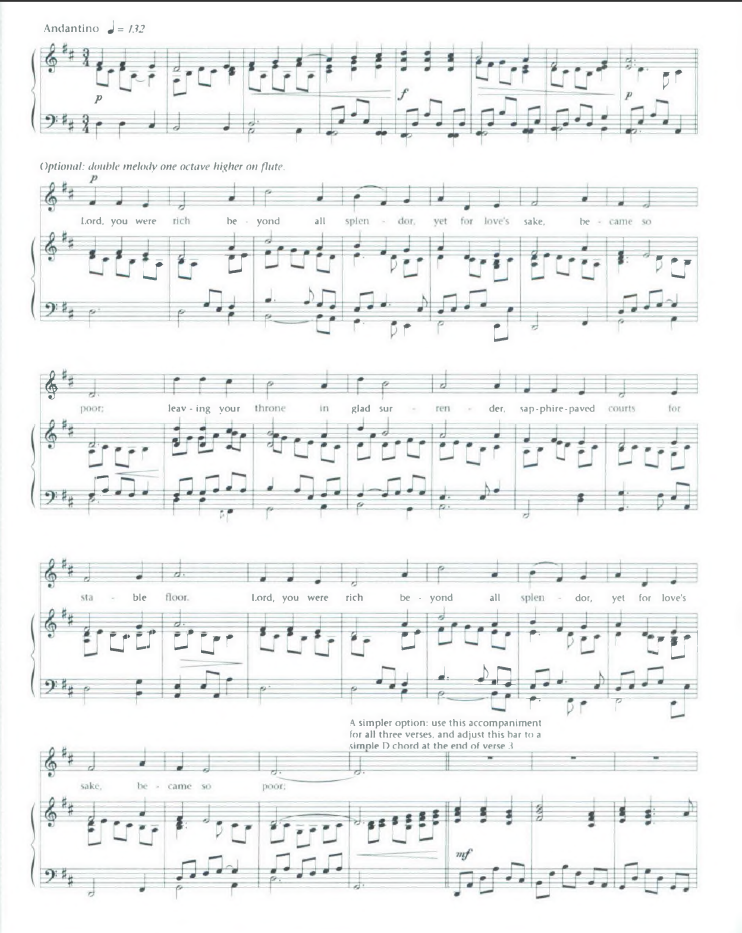
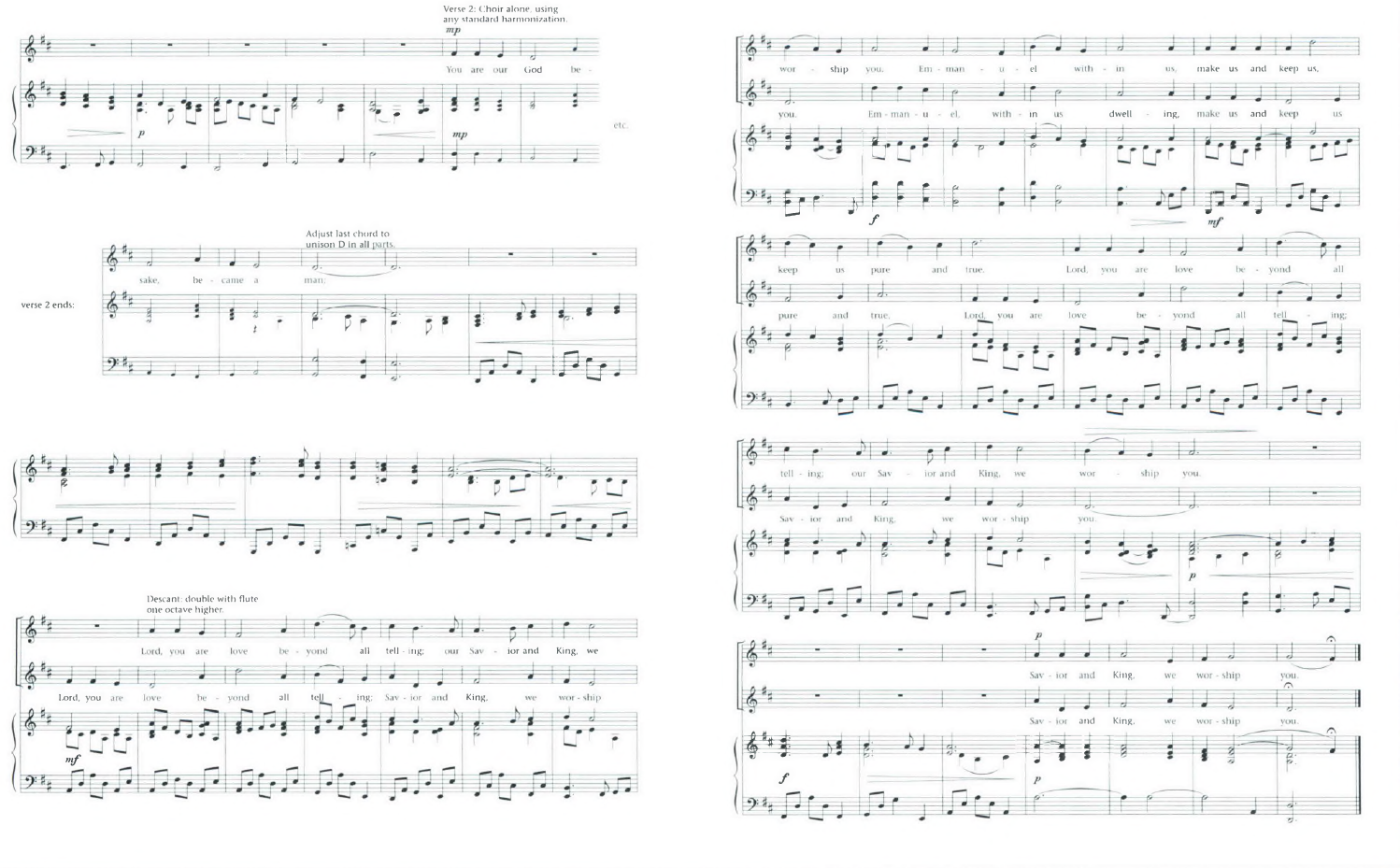
Copyright
Holders of CCLI, LicenSing, and OneLicense.net licenses may use this text without additional fee and should report its use to Hope Publishing Co., which administers copyrights for Jubilate Hymns in North America. Others may seek permission online at www.hopepublishing.com or by phoning 800-323-1049. The melody, which is public domain, as well as this arrangement by Roger Bergs, may be freely copied and used by congregations for their services of worship.
Christmas: While Shepherds Watched Their Flocks by Night
And the angel said to them, “Fear not, for behold, I bring you good news of great joy that will be for all the people. For unto you is born this day in the city of David a Savior, who is Christ the Lord.”
— Luke 2:10–11
I was torn recently, when reading John Bell’s marvellous book The Singing Thing (GIA, 2000). The author, whom I admire and respect, supported an argument that I agreed with by disparaging one of my favorite Christmas hymns! He maligned the tune WINCHESTER OLD, using the pithy Gaelic descriptor dreich, arguing “this limp and joyless melody. . . is totally inadequate to accompany a text about the announcement of such a stupendous event as the incarnation.”
He’s right—to a point—if you just sing this hymn as one identical verse following another, with no overall thrust or drama. But that kind of singing can kill even the best of congregational song. The problem is not unique to this hymn and ignores the support that a well-crafted accompaniment can provide.
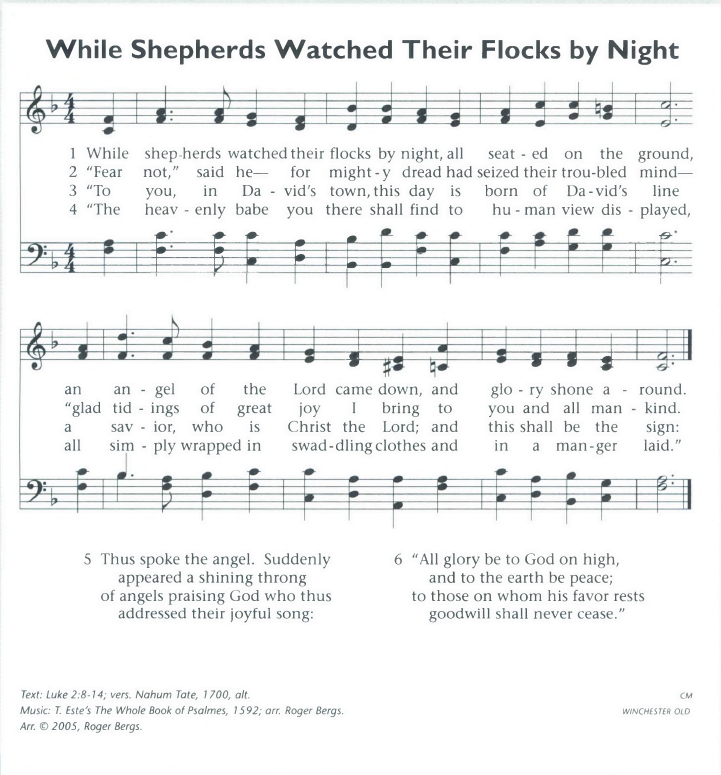
Consider this well-known parallel: About 1962, a bossa-nova hit entitled “The Girl from Ipanema” took the popular music world by storm. If you were to take the tune itself out of the context of its accompaniment, it might also fit the description “drab and lifeless”: it is in the variety and vitality of its accompaniment that it is lifted from dreich-ness to a mesmerizing memorability. So it falls to instrumentalists and song leaders to recognize the drama of the text and furnish the relevant emotional climate.
With this song, drama is indeed the issue. Unlike the overwhelming majority of Scripture paraphrases we sing—psalms, prophetic texts, didactic texts (such as the Beatitudes)—this paraphrase tells a story, and its singing must be treated as musical drama.
The text author Nahum Tate (1652–1715) was a distinguished playwright who became Britain’s poet laureate. His metrical Psalter of 1696 (with collaborator Nicholas Brady) was a popular lyrical update to the earlier and poetically less-polished Scottish psalters of the previous two centuries. The tune WINCHESTER OLD is a common meter standby that first appeared in 1592 in Thomas Este’s Psalmes, a collection of tunes designed to support earlier psalm paraphrases.
Any introduction must depict the quiet, restful Judean countryside and not give away the tumultuous events to come. I offer a version for organ, in which I attempt to let the accompaniment depict the twinkle of stars, and the more relaxed half-note harmonic rhythm create a mood of sleepy relaxation, free of the ponderous accent-on-every-quarter-note feel that is fatal to this piece.
The six stanzas in this text are not self-contained units. There are various degrees of linkage that reduce or eliminate the possibility of “pausing to reflect” each time we hit the end of the tune. Allow no extra time between stanzas 2–4, or 5–6. In contrast, extra time at the end of verse 4 is actually helpful, and optional at the end of verse 1. Extra time could take the form of a fermata on the last note, a repetition of the final six melody notes, or a rotation of chords acting as a bridge. The following notes may enhance your accompaniment of this carol:
- Stanza 1 must begin quietly. The appearance of the angel, though frightening to the shepherds, does not necessitate a lot of noise.
- Stanza 2 could begin with a reharmonization in the relative minor (suggesting fear), moving back to the tonic major for the second line (as the instruction to “fear not!” is heeded).
- Stanzas 3 and 4 convey copious information. One possibility here is to imagine how the minds of the shepherds, adrenaline racing, must have been overwhelmed with wonder, struggling to take it all in. Adding some eighth-note motion to the accompaniment helps convey this.
- Stanza 5 is the crescendo, and it should be dramatic; but save some dynamic room to make sure that stanza 6 (especially the end) remains the true climax. A solid soprano section or a good trumpet (ideally both) can use the descant supplied to reinforce the full joy of this moment.
- If you are leading this song using a worship band, avoid feeling you need to replicate the quarter-note harmonic rhythm of the hymnal setting: two chords per measure should be enough and will allow for a variation of accompaniment patterns. Simple finger-picking for stanza 1 can crescendo through patterns of increasing momentum, culminating in a stanza 6 that is majestic but less busy than the lead-up to it.
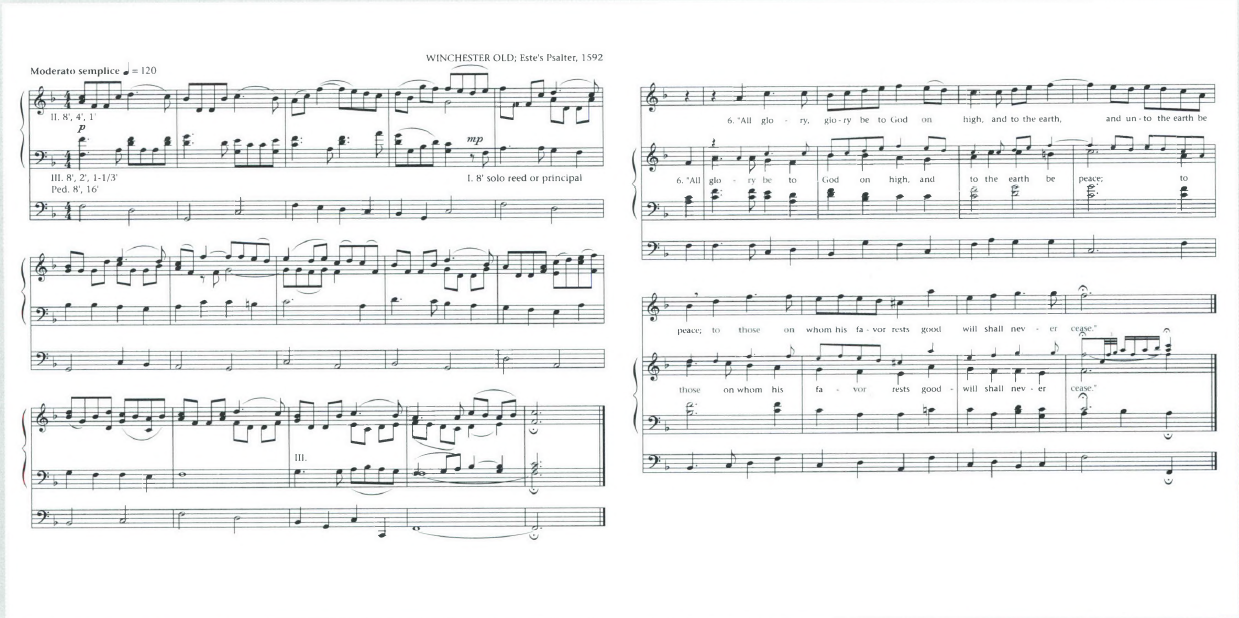
Copyright
The text and music of this hymn are in public domain and may be used without fee or permission. Roger Berg’s introduction and accompaniment for stanza 6 may also be freely copied and used by congregations for their services of worship.
Epiphany: As with Gladness Men of Old
Now after Jesus was born in Bethlehem . . . behold, wise men from the east came to Jerusalem, saying, “Where is he who has been born king of the Jews? For we saw his star when it rose and have come to worship him.”
—Matthew 2:1–2
The Bible tells us little about the origins of the “Magi from the east,” whose story is told in Matthew 2. Recent commentaries tend to suggest that they were Persian scholars. (One interesting theory links them to the traditions of Chaldean-Medo-Persian “magicians, enchanters, astrologers and diviners” found in the book of Daniel, and their search for a Jewish King to Messianic prophecies taught by Daniel himself!)
Yet today, many Chinese Christians find their imaginations stimulated by the possibility that these intriguing characters may have travelled from points further east. Singing their story to a popular Chinese folk tune certainly adds one kind of eastern flavor not present in the standard version.
The text by William Chatterton Dix (1837–1898) was written during Epiphany in 1860, while Dix was sick in bed. It was published in 1861 in a collection called Hymns of Love and Joy. Dix worked by day managing an insurance company in Glasgow, but his avocation was the poetry of worship. Although his total output was only about forty hymns, they include such favorites as “What Child Is This?” and “Alleluia, Sing to Jesus!”
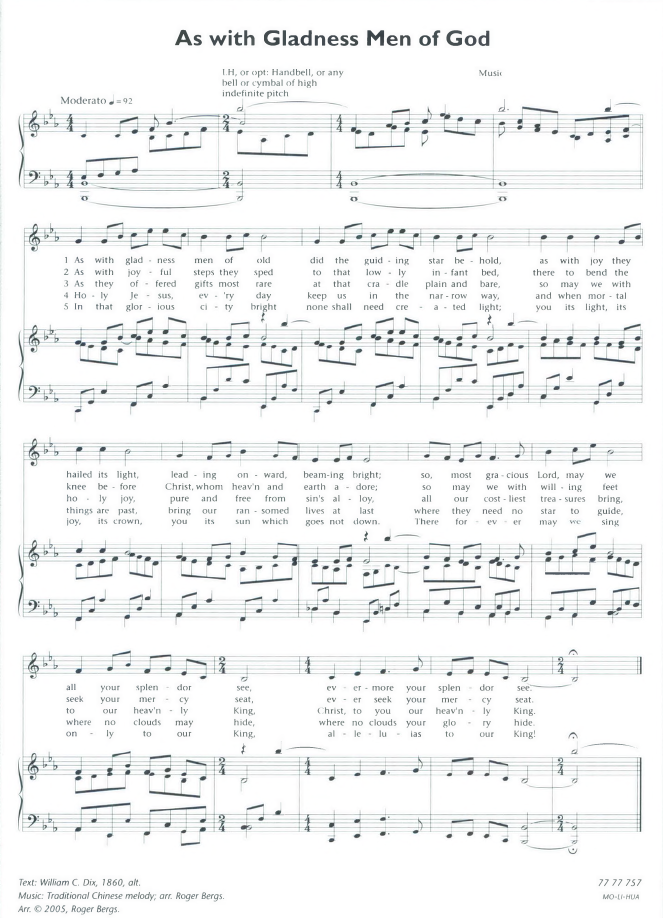
Stanzas 1–3 each begin with a summary of activities and attitudes of the Magi, and conclude with a prayer of application for us in the present. The final stanzas remind us how our pilgrimage today parallels the Magi’s journey two thousand years ago, and how the light that guided their journey reveals a glimpse of heavenly glory—the endpoint of our lifelong pilgrimage as Christians.
The tune introduced here, titled MO-LI-HUA, is among the best-known and -loved of all Chinese folk melodies. The title refers to the smell of jasmine, and the original text compares the qualities of a beloved to the sweetness of that smell. Nearly a billion people on earth know this melody front to back. Using it to link their heritage with the central event of history is a powerfully inclusive gesture.
The accompanying arrangement gives a brief introduction and piano accompaniment. The addition of a small bell or cymbal is effective. The use of any Chinese instruments (Er-Hu, Zheng, Di-Zi or Xiao—Chinese violin, harp/dulcimer, flute, recorder) would be ideal. In their absence, a flute or violin doubling the melody line adds a tasteful depth of character.
Copyright
The text and melody are in public domain and may be used without fee or permission. Roger Berg’s accompaniment may also be freely copied and used by congregations for their services of worship.
